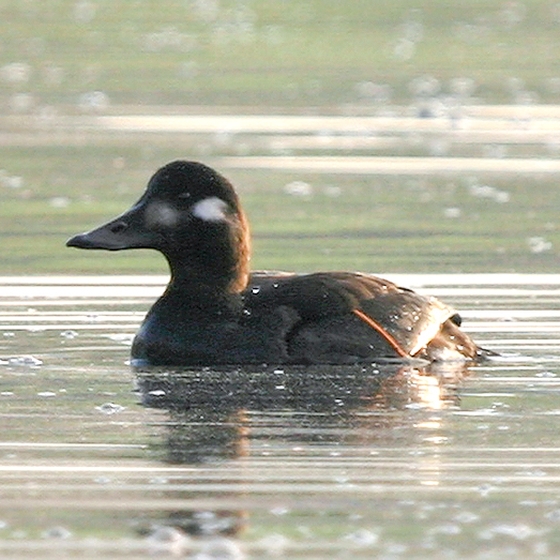Velvet Scoter

Introduction
This largely black seaduck, with white wing patches, is a winter visitor and passage migrant to UK coastal waters.
Velvet Scoters begin arriving on UK waters during late summer and undertake a post-breeding moult. As the autumn progresses these early birds are joined by more individuals and numbers continue to build through the winter as more birds move south from the Scandinavian and arctic Russian breeding grounds. At this time some Velvet Scoters move south and west into the English Channel.
Wetland Bird Survey data reveal that a small number of Scottish bays and estuaries hold the majority of wintering Velvet Scoter in the UK. Numbers can fluctuate between years but the wintering population has been estimated to number just over 3,000 individuals.

Key Stats
Identification
ID Videos
This section features BTO training videos headlining this species, or featuring it as a potential confusion species.
Scoters
Status and Trends
Conservation Status
Population Size
Population Change
Velvet Scoter is a winter visitor to the UK. Although some arrive to moult in Scottish waters in the late summer, most are not present until November Balmer et al. 2013]. The species is predominantly seen offshore and is most prevalent off eastern and southern coasts, although it is occasionally recorded at inland sites. There are no coordinated or regular surveys carried out in the UK for marine waterbirds and no long-term monitoring programmes that adequately cover offshore areas, so it is difficult to gather accurate count data or track population changes for species such as Velvet Scoter. [WeBS data for Velvet Scoter show fluctuations in the numbers recorded over time, but no overall population trend; however, data gathered for EU Birds Birds Directive Article 12 reporting suggest a decline for the UK population of 59% between 1999 and 2010 [Dagys & Hearn 2018].
Distribution
The Velvet Scoter has a coastal distribution that is almost continuous from Shetland southwards along the North Sea coast and along the south coast of England; it is patchier elsewhere.
Occupied 10-km squares in UK
or view it on Bird Atlas Mapstore.
or view it on Bird Atlas Mapstore.
European Distribution Map
Distribution Change
There has been a 65% increase in the number of 10-km squares occupied by Velvet Scoters since the 1981–84 Winter Atlas. Some gains may reflect improved coverage but increases in Shetland and the Firth of Forth and the losses in Orkney are probably genuine.
Change in occupied 10-km squares in the UK
or view it on Bird Atlas Mapstore.
or view it on Bird Atlas Mapstore.
Seasonality
Velvet Scoters are mostly winter visitors, with records peaking in late autumn. Some birds are known to summer and others arrive in late summer to moult in British waters.
Weekly pattern of occurrence
The graph shows when the species is present in the UK, with taller bars indicating a higher likelihood of encountering the species in appropriate regions and habitats.

Movement
Britain & Ireland movement
European movements
EuroBirdPortal uses birdwatcher's records, such as those logged in BirdTrack to map the flows of birds as they arrive and depart Europe. See maps for this species here.
The Eurasian-African Migration Atlas shows movements of individual birds ringed or recovered in Europe. See maps for this species here.
Biology
Productivity and Nesting
Nesting timing
Egg measurements
Clutch Size
Survival and Longevity
Survival is shown as the proportion of birds surviving from one year to the next and is derived from bird ringing data. It can also be used to estimate how long birds typically live.
lifespan
Survival of adults
Classification, names and codes
Classification and Codes
- Order: Anseriformes
- Family: Anatidae
- Scientific name: Melanitta fusca
- Authority: Linnaeus, 1758
- BTO 2-letter code: VS
- BTO 5-letter code: VELSC
- Euring code number: 2150
Alternate species names
- Catalan: ànec fosc
- Czech: turpan hnedý
- Danish: Fløjlsand
- Dutch: Grote Zee-eend
- Estonian: tõmmuvaeras
- Finnish: pilkkasiipi
- French: Macreuse brune
- Gaelic: Lach-dhubh
- German: Samtente
- Hungarian: füstös réce
- Icelandic: Korpönd
- Irish: Sceadach
- Italian: Orco marino
- Latvian: (tumša pile), velna pile
- Lithuanian: paprastoji nuodegule
- Norwegian: Sjøorre
- Polish: uhla (zwyczajna)
- Portuguese: negrola-d'asa-branca
- Slovak: turpan tmavý
- Slovenian: beloliska
- Spanish: Negrón especulado
- Swedish: svärta
- Welsh: Môr-hwyaden y Gogledd
- English folkname(s): Astracannet
Research
Causes of Change and Solutions
Causes of change
A comprehensive survey of wintering Velvet Scoter in the Baltic Sea (where the majority of the population overwinters) carried out between 2007 and 2009 found that the population had declined by c. 60% since the early 1990s, which corresponds with the decline seen in the UK wintering population. Internationally, this decline is thought to be due to a combination of reduced survival and reduced reproductive output. Although the exact root causes of these declines have not been confirmed, the following have been identified as contributing, directly or indirectly, to increased mortality: by-catch of wintering birds in fishing gear, accidental and diffused oil pollution, hunting, predation by non-native species, effects of windfarms and other developments [Dagys & Hearn 2018]. It is unlikely that these factors are solely responsible for the declines however, given these factors have not changed dramtically in recent decades. Disturbance of breeding birds in the Baltic archipelagos has also been identified as a potential threat.

